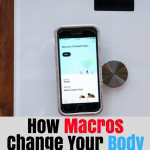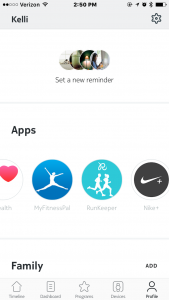Thank you Nokia for sponsoring this post. Visit the Nokia Body + site for more info and start the new year off right!
What are Macros?
Macros are short for macronutrients. There are three types of macronutrients you can consume these are:
Foods often contain a mix of protein, fat, and carbohydrate but one is usually predominant over the others.
What are Calories?
Calorie is the amount of energy in a given food. The number of calories provided by a food depends on its macronutrient content. For every 1 gram of:
- protein, 4 calories are provided.
- Net carbohydrate (carbohydrate minus fiber), 4 calories are provided.
- Fat, 9 calories are provided.
In order to lose weight, you do need to be a slight calorie deficit, meaning you burn slightly more than you intake (but above your basal metabolic rate).
However, the ratio of macronutrients that make up the calories you consume determines how full you will be, your energy levels, hormone status, and resulting body composition.
What is Body Composition?

Body composition is how the pounds you weigh are distributed into:
- Fat
- Muscle
- Water
- Bone Mass
How Do Macros Affect Body Composition?
The first time I lost weight in college I did it the wrong way, and since becoming an RD I see this mistake over and over again. Only paying attention to calories may lead to weight loss, but it won’t give you the results you want. If you want a lean trim body, yes, you may need to drop a few extra pounds. However, if those pounds you drop are predominately muscle mass you will end up looking like a smaller version of your current self. In other words, you won’t have any tone or definition.
Protein – helps maintain, rebuild, and repair muscle mass. Getting enough protein throughout the day helps to preserve your muscle mass so that the weight you lose is fat not muscle mass.
- If your muscle mass starts to drop, you may need to up your protein intake.
Carbohydrate – for the purposes of this post, we are referring to net carbohydrate (total amount of carbohydrates minus fiber.) There are two types of carbohydrate fiber-rich non-starchy vegetables and energy-rich starchy carbohydrates. Non-starchy carbohydrates, mostly vegetables, help keep you full and supply micronutrients. Starchy carbohydrates give you energy, it also helps you recover from your workouts.
- As you get closer to your goal weight/body fat percentage the more carbohydrates you need.
- If you start to gain body fat or weight, you may be consuming too many calories/carbohydrates or both.
- If you start to lose muscle mass, you may need more carbohydrates or you may need to time your carbohydrates to help your muscles repair.
Fat – there are many types of fat, some good, some controversial, some bad (for more info read this post.) Healthy fats are key to burning fat off your body. They suppress appetite, train your body to burn fat instead of sugar and nourish your body.
- If you are hungry all the time while losing weight, you may need more healthy fat in your diet.
- If you lower your carbohydrate intake, you may need more healthy fat.
How Monitoring Your Body Composition Helps You Adjust Your Macros
Knowing more than just your weight is key to getting the results you want. Here are a few examples:
You step on the scale one week and it’s gone up! Possible scenarios include:
- You’ve gained water and muscle, fat’s gone down.
- You’ve gained water.
- You’ve gained water and muscle.
- You’ve gained fat.
You step on the scale one week and it’s gone down! Possible scenarios include:
- You’ve gained muscle and water, lost body fat.
- You’ve lost muscle and water, body fat is the same.
- You’ve lost body fat.
Monitoring your body composition means you can make adjustments quicker.
For instance, if you start losing muscle mass frequently, you can increase strength training and protein.
If you are gaining water, you won’t have a freakout, especially right before your period.
If you are an endurance athlete, you can monitor for dehydration by looking for lack of water.
If you start gaining fat you can make adjustments to your cardio, calories, carbs, and fats.
Tracking Your Macros & Body Composition
As you can see there are a lot of variables at play when it comes to weight loss. It's important to keep track of everything in one place so that you can analyze your results and make adjustments as needed. I recently got the chance to check out the Nokia Body+ Wi-Fi. This scale and the Health Mate App makes it SUPER easy to track what you eat, your activity, health, and body composition in one place.
I love that the app integrates with all my favorite apps like MyFitnessPal, Runkeeper, and Nike Plus!
I also loved that they have 8-week health challenges and a pregnancy mode. How often do you see a scale that comes with a pregnancy mode? NEVER! They just focus on losing those post-baby pounds. This system is great for keeping mamas healthy before and after baby!
The Nokia Health Mate App & Nokia Body+ Wi-Fi Scale allow you to have all the data you need in one place to break through plateaus and move you forward towards your goals faster and with more precision.
(Get 10% off at the Nokia Health store through December 1, 2018, here with this code: NEWYOU-TK1-36R)
I was selected for this opportunity as a member of CLEVER and the content and opinions expressed here are all my own.










Patricia @Sweet and Strong says
Such an informative post! I stopped stepping on a scale years ago because I knew just my weight wasn't an accurate measurement of keeping track of my body. Love the idea of this scale that tracks your BMI!
kathleen says
Curious as to how to get enough protein while being dairy free - definitely missing my cottage cheese and greek yogurt!!
Kelli Shallal MPH RD says
Hi Kathleen, I'm not 100% dairy free but my husband is. He just eats bigger portions of meat when he eats protein and sometimes has vegan protein shakes. I will say collagen helps us both get enough dairy free protein!